Streatham Hill Theatre- A Tour!
Back in the 1920s Streatham Hill in London acquired a nightlife that made it the envy of any London suburb. Not only did it get a brand new theatre, The Playhouse, but it had a purpose-built palais- de-danse, the Locarno, the Gaumont cinema, and eventually an enormous ice-rink.
The Streatham Society, as part of the Streatham Festival, negotiated with Beacon Bingo to allow a tour of the Streatham Hill Theatre, formerly the Playhouse – possibly the first time this has happened in 50 years. The theatre closed its doors in June 1962 and re-opened as a bingo hall in November of that year.
Brian Bloice of the Streatham Society fronted a tour which explored this Grade II listed building from the under-stage areas to the roof, taking in the auditorium, foyers, circle and gallery. I think the society were expecting some interest, but from the off, as the foyer filled up, you could tell that they were amazed at the large turn-out. A lot of people wanted to explore this huge building that has been home to the stars for so many years.
My “party” comprised of my brother, Vivyan, Andrew Ryan and James Horne. A thespian group determined to take a look around this grand reminder of the Golden Age of theatre. Vivyan has a website dedicated to Theatre and Music History. It lists all London theatres since 1567. It also gives details of every London Musical since 1920.
Vivyan’s website is: www.overthefootlights.co.uk
We were joined by Freddie Lees- a resident of Streatham for many years, and his friends Robert Bailey and Margot Hewitt. Freddie recalled seeing Frankie Howerd in pantomime here, playing Buttons. Freddie’s friend Helen Cotterill played Cinderella in that show, and was later to join Freddie at the London Palladium in “Oliver”. They played Mr & Mrs Sowerbury in that long running musical.
I think they were expecting fifty people to join the tour- I’d estimate a hundred plus people ended up having a great time exploring the hidden parts of the Streatham Hill Theatre, and learning about its history. It was cosy to say the least! We started in the foyer and the upper foyer, before climbing the stone steps to the very top of the building, and on to the roof, with a view of what was once The Locarno and the Gaumont. Now both closed up and derelict.
When the theatre opened in 1929 it was one of several entertainment venues in Streatham. The Locarno dance hall was opened by band-leader Billy Cotton in 1929 and was the most popular purpose-built dance-hall in London. Between then and its closure in 2010 the Locarno has seen the likes of Glenn Miller, the Rolling Stones, Rod Stewart and the Miss World competitions. In its time it has been a nightclub, named-the Cat’s Whiskers (1969), the Studio (1984), the Ritzy (1990) and finally Caesar’s Nightclub in 1995. Here’s a view of the Locarno then and now:
The Theatre itself occupies a half-acre plot. The foundation stone was laid by Evelyn Laye in September 1928 while she was appearing in “Blue Eyes” at Daly’s Theatre in the West End. Ironically the first show that opened the theatre in 1929 starred her husband, Sonny Hale, and his mistress, Jessie Matthews. Evelyn Laye was in the process of divorcing Sonny Hale for his infidelity, whilst Lord Lytton was divorcing Jessie Matthews for her adultery with Sonny Hale. The opening show was called “Wake Up and Dream”.
At 2,523 seats (23 seats more than the London Coliseum) the Playhouse was one of the largest theatres in Britain – larger than the London Palladium, it had one of the highest proscenium arches in the country. Seating capacity in the stalls was 1,091, with 738 in the Dress Circle and 694 in the Balcony. The architects were W.G.R. Sprague and W.H. Barton, both of whom had served their apprenticeships with the legendary Frank Matcham. Streatham Hill Theatre was the last of 36 London and provincial theatres designed by Sprague.
The upper circle or Gallery is intact, with all the seats intact, as is the Dress Circle. Apparently the original colouring of the theatre was Dull gold, white and a russet brown. Certainly, under their layers of dust the seats look a reddish brown. I was surprised to see seats- in fact only the area that was the stalls and the stage have been altered. The rest, including the corridors are just as they were when the theatre ceased to be.. a theatre.
It was intended as a Number One Touring venue and a pre-West End showcase. In its thirty-three years as a live theatre it was home to Shakespeare, opera, ballet, plays, musicals and pantomime. Amongst the stars who appeared were John Gielgud as Hamlet, Paul Robeson, Peggy Ashcroft and Sybil Thorndike in the legendary “Othello”; Anna Pavlova in her famous “Dying Swan”; opera singer Richard Tauber; the D’Oyly Carte Opera Company; Alastair Sim and Fay Compton; Jean Forbes-Robertson as Peter Pan, and later Joan Greenwood in the same role; and Emlyn Williams and Sybil Thorndike in “The Corn is Green”. In 1951 the Hollywood star, Bela Lugosi, appeared live on stage as Dracula.
Ivor Novello appeared frequently. During the run of his play “I Lived with You”, he was visited backstage by Laurence Olivier and Douglas Fairbanks Jnr and his wife Joan Crawford. Fans besieged the stage door for several hours after the show.
Local actresses Patricia Hayes and Hy Hazell made their debuts at the theatre, and established stars like Peggy Mount, Kathleen Harrison and Thora Hird drew in the crowds. Michael Caine appeared alongside Frank Finlay and Roy Kinnear in “The Long & the Short & the Tall”. Local variety stars, Tommy Trinder and Roy Hudd brought variety to the audience, as did Billy Bennett, Elsie & Doris Waters, Max Miller, George Formby, Old Mother Riley, Tommy Handley and Sophie Tucker.
Streatham Hill Theatre was famous for its musicals on their way in and out of town. These included Lilac Time, Maid of the Mountains, The Belle of New York, the Chocolate Soldier, Blackbirds of 1935, On Your Toes, Careless Rapture, The Desert Song, The Student Prince, Oklahoma, Zip Goes a Million, Carousel, Call Me Madam, Love from Judy, and Cole Porter’s Can-Can (Isobel Hurll remembers playing Streatham Hill and its sister-theatre the Golders Green Hippodrome with this production of “Can Can” when she was in her early teens).
As part of the tour, we were escorted to the bowels of the theatre, beneath the bingo tables and one-arm bandits, to inspect the stage-traps which are still intact to this day. Apart from the individual and demon-traps, the centre trap is so large that it enabled the most spectacular sinking of the Titanic when Noel Coward’s “Cavalcade” made its post West-End tour in 1932. It is still a spectacular piece of stage equipment when viewed eighty years later.
Pantomime at the Streatham Hill Theatre
The first pantomime was in 1935 and was very much a local affair. It starred Streatham residents Billy Caryll and Hilda Mundy along with Robert Hale as Dame in “Dick Whittington” with Brixton’s Egbert Brothers, Patricia Burke making her debut as Alice, and Eugene’s Flying Underwater Ballet. The pantomime ran for three weeks, but was followed by a second pantomime, transferring from the Golders Green Hippodrome – “Aladdin” starring Polly Ward.
In 1936 Prince Littler became pantomime producer at Streatham, opening his tenure with “Humpty Dumpty” followed in 1937 with “Jack and the Beanstalk”, starring Ted Ray, Shaun Glenville as Dame, with Marie Burke (mother of Patricia Burke) and “Baby Terry” as Fairy. The 1938 panto was “Sleeping Beauty”, and the first wartime panto saw Barry Lupino as Widow Twankey in “Aladdin”. This pantomime featured Wilson, Keppel and Betty.
During the war Stanley Lupino played Mother Goose in 1940, Douglas Byng was Dame in “Humpty Dumpty” in 1941, and one of the most popular wartime pantomimes was the 1942 “Cinderella”, which starred Freddie Foss as Buttons and Nancy Burne as Cinderella. According to The Stage Freddie Foss’s “little burlesque of Hitler in the ballroom scene was cleverly done”. In 1943 145,000 people attended “Sleeping Beauty”, the last pantomime for several years due to wartime damage.
Bomb damage
At 6.30am on the morning of Monday July 3rd 1944 a flying bomb destroyed the side wall of the theatre. Sleeping inside the theatre, because of earlier bomb damage to their property, was an air-raid warden and his family – allowed to remain on fire-watch duty. The bomb caused a gaping hole 60ft in diameter, damaging much of the interior and both sides of the proscenium arch. The only fatality was the warden’s mother-in-law. The extent of the damage was such that the theatre was closed for many years to come.
Re-opening and Post-War Pantomimes
Following repairs at the end of the war, the Streatham Hill Theatre reopened on Boxing Day 1950 with the pantomime “Cinderella”, a repeat of the 1942-43 production. Nancy Burne again played Cinderella, Freddie Foss now played Ugly Sister and in the small role of Broker’s Man, was an unknown Clive Dunn.
The 1951-52 pantomime was “Mother Goose” with Beryl Reid as Gretchen, Jill Manners as Colin, and George Gee in the title role. The following year was “Humpty Dumpty” with Leo Franklyn as Dame (he did his first Dame in 1938 at the Duke of York’s), Pearl Newman, Bert Rich and Wallace Lupino, and Stan Little in the title role.
The 1953-54 pantomime was Prince Littler’s last at Streatham. The subject was “Sleeping Beauty” with Anne Ziegler (without Webster Booth!) as Prince, Eddie Henderson as Dame, with Bert Murray, Valerie Carton and Peter Dulay (best remembered as the host of TV’s Candid Camera).
The 1954-55 “Humpty Dumpty” was a Jack Hylton production directed by Ralph Reader (of Gang Show fame) . The big names were Laurie Lupino Lane and George Truzzi, and the rest of the cast included Dick Emery as Dame, Eve Lister as Principal Boy and Anthea Askey (daughter of Arthur) in the title role. The following year was a “Babes in the Wood”, this time with Arthur Askey himself as Big Hearted Martha, with Patricia Burke as Robin Hood.
The 1956-57 pantomime was “Goody Two Shoes” presented by Jack Hylton and Emile Littler, and starring Tommy Fields (“Gracie’s clever little brother”) as Dame, with Desmond and Marks, and the young Alan Vickers as the Yellow Dwarf. (Alan was later to team up with Simon Barry as Ugly Sisters for many years). This pantomime included the “march of the kilted, torch-bearing Highlanders” with wailing pipes, beating drums and a great cascade of water splashing in the background. The next pantomime was “Puss in Boots”, again a Jack Hylton/Emile Little production, with the first act running over two hours on opening night! It starred Jimmy Edwards, Margaret Burton and Sonny Jenks as Dame.
The 1958-59 “Aladdin” starred Hughie Green as Abanazar and Shani Wallis as Aladdin, with Laurie Lupino Lane and George Truzzi as Policemen, Artie Mayne as Twankey and Ken Wilson as Wishee-Washee, performing his famous deck-chair routine. The speciality was Emerson and Jayne.
1959-60 was a “Dick Whittington” starring Arthur Askey as Idle Jack, Eve Lister as Dick, Eddie Molloy as Sarah the Cook and Sadie Corré as Tommy the Cat. Alice was played by Judy Carne, who was later to star in the American TV series “Rowan and Martin’s Laugh In” and become famous with the catchphrase “Sock it to Me”. At one time she was married to Burt Reynolds.
The 1960-61 “Cinderella” had Frankie Howerd as Buttons, accompanied by Madame Sunny Rogers, with Sonny Dawkes and Gary Wenn as the Ugly Sisters, and Helen Cotterill as Cinderella. Jean Telfer played Prince Charming and Christine Taylor was Dandini.
The last pantomime at the Streatham Hill Theatre was in 1961-62, and was “Jack and Jill”. Streatham-born Tommy Trinder starred as Dame Horner, the first time he had played Dame even though he had been in the business for forty years. Joining him in this production were Allan Bruce as Jack; Jane Fyffe as Jill (she was the sister of Dame Hilda – Patrick Fyffe); Don Arroll; and Sid Plummer (who also performed a xylophone speciality. I had the joy of working with Sid on a few Music Halls for Jan Hunt’s Paper Moon Company. The last time was about five years ago.)
After the theatre closed Pantomimes were sometimes presented at the nearby Odeon Cinema. Pop stars and current television stars drew the crowds.
The end of an era
By the 1960s, in spite of large audiences for pantomime and musicals, most of the time the theatre was just one third full. Television took its toll, and the new craze for bingo took hold. A few months before the theatre closed Mecca tested bingo sessions at the Locarno and were very impressed with the results. On June 4th 1962 the last show opened at Streatham Hill, Jean Anouilh’s play “The Rehearsal”. By now Mecca had taken possession of the Locarno and the Ice Rink. The theatre closed its doors for the summer with speculation as to its future. In November of that year Mecca took control of the Streatham Hill Theatre and re-opened as a Bingo hall. 2000 people came through the doors on that first night. The fate of Streatham Hill Theatre was sealed.
Luckily, as the tour proved, much of the theatre remains intact – more so in fact than the London Hippodrome. And luckily too, the building itself was awarded a Grade II Listing for its architectural and historical value. Fortunately, under Beacon Bingo, the present occupiers, the building is used by 3,000 people a week, keeping it alive and in good order front-of-house.
Many thanks to the Streatham Society and Beacon Bingo for allowing us the chance to explore areas of the theatre that have not been open to the public for half a century.
My thanks to John Cresswell’s excellent book, “The Streatham Hill Theatre” which is published by The Streatham Society, available from 219, Sternhold Avenue, London SW2 4PG priced at an extremely reasonable Five Pounds!




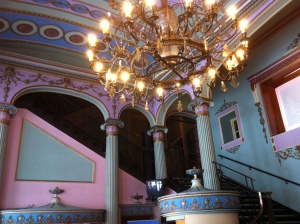




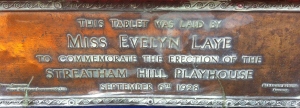


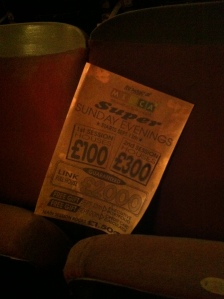

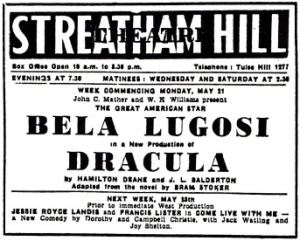


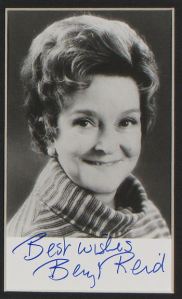





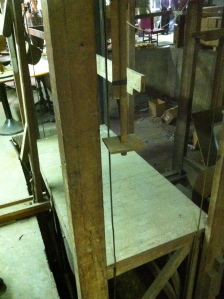


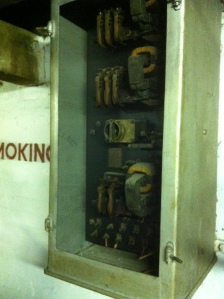












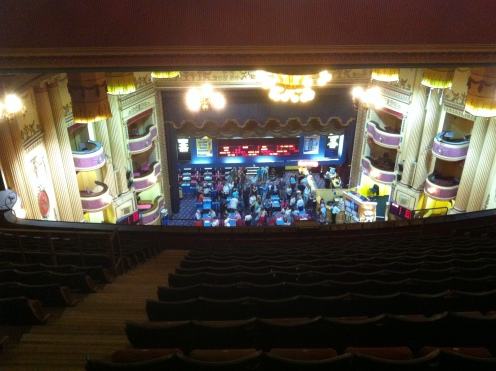
Thanks for this. I had been thinking of going, but the weather lured me to the seaside!
Great to see this blog I lived in poynders road and my mum was cleaner and usherette at the theatre and me and my brother both worked there as stage hands,dressers,and props, remember Dickie Bird
the head flyman,and also Winston Churchill going to the D,oyly Carte opera.
Hi, great piece. How can I get in touch with you, as would love to use some of this in an article?
email Nigel info@its-behind-you.com
My e.mail address keith44twine@btinternet.com I will get the grey cells working
Dear Nigel, Thanks a million for this backstage history of the Streatham Hill Theatre. I Googled it to find out more about the venue I’ve been booked to play in a couple of weeks and feel honoured at the prospect of bringing my live singalong show to a theatre with such a history! Lovely to see some of the stars I worked with in the 60’s played here: Dick Emery, Frankie Howerd and Hughie Green. Please visit my website for more about the sister club to the Talk of the Town where I worked with these Streatham Hill Theatre pros: http://www.thegoldengarter.co.uk
*
Have a good run in Hull. Break a leg Nigel! Kind regards, John Orchard
Can you help me I was in pantomime in the early 60s at the golders green hippodrome with tommy trinder I was one of the terry children can you please let me know if I can aquire any photos from the show thanks
I went to the Theatre more times than I can remember in the 1950`s – saw my heart-throb Dirk Bogarde in `Summertime`, and believe it or not, a very young Sean Connery with a 2 minute part as Buzz the pilot in South Pacific! Always sat in the `Gods` due to lack of money and cheap seats! It was nice to see the lobby, as, being in the `Gods` we entered the theatre from an outside side door, up numerous steps and left the same way, never seeing the lobby at all. Wish I still had my programmes, which fell by the wayside when I left England for Canada.
Hi Nigel, I appeared twice at Streatham once in the 1960 Cinderella with Frankie Howard and then in 1961 with Tommy Trinder. I was in a group called Terrys Juvenilles and funnily enough this is the dance troup Jesse Mathews started in. Do you know if any threatre photos of the production exist.
Sandra
Hello!
Thanks for the info regarding Terry Juveniles- I’ve had several in the past and unfortunately have drawn a blank – the companies that presented the pantomimes mostly went out of business and their collections vanished. Always worth checking with the Victoria and Albert theatre museum section, and going online to look up your pantomimes in the Stage Archive- sometimes the reviews were accompanied by a press release photo now and then?
Hope you find a photo somewhere!
Regards
Nigel
Sandra, Do you have any photos? The Streatham Society would love to see them?
Fascinating article! We lived just across the side road to the theatre. I always knew that I started a life in ballet because I went on stage during a pantomime when I was three years old! Apparently, I looked so at home on stage that my mother sent me to ballet lessons. I was thrilled therefore to discover from your article that that was in Cinderella, the panto that reopened the theatre in 1950!
I still have the Cinderella programme with my mum’s notes written in it and also some other signed programmes Dame Sybil Thorndike for sure .. The others I’ll dig out I think there’s a Peter Pan prog too
We were regular rep goers for many years
I used to sit up in the gods in saturday matinées and then go round to the stage door for autographs
must have been 11ish We lived a five minute walk from the theatre
The picture of the Locarno exterior is actually the Glasgow Locarno.
I grew up through the WW2 years in Balham, Battershill’s of Balham being my father’s business. I attended Streatham Hill and Clapham High Sch., then in Wavertree Road, from 1945- 1957. We went to the Pantomimes at Streatham Hill Theatre before and after it was bombed in 1944. I saw my first Ballet at the theatre, plus many plays including Shakespeare performed on the stage there, and spent a great deal of time at the stage door collecting autographs. The Streatham Theatre was a large part of my early life. Thank you for the blog. Helen Henton, nee Battershill
Lovely stuff, thank you!
My Dad used to take me to the pantomime here every year followed by a trip to the West End to see the lights and tea in Lyons Cornerhouse!! The last panto we saw was Cinderella with Frankie Howard and I remember him singing his Three Little Fishes song and my friend and I laughing so much we were crying!!
Thanks to these happy trips to Streatham Hill Theatre I always ensured my children went to a panto
when they were growing up and my grandchildren too. I think it is such a shame when children and indeed lots of adults, say they’ve never been to a theatre.
Mecca carried out a major redecoration of the Theatre, including auditorium, foyer, and all ancillary areas in 1975. We remained open for business throughout, which resulted in the project taking six months to complete. The architect for the scheme was Tony Hodge. Although the main use had changed under Mecca, management and staff remained extremely proud of the building, and always paid due attention to its care as well as running the business operation.
(I was appointed General Manager at Streatham Hill Theatre 1974 to 1980)
A very fine article-I used to be a regular in the 60s-I would like to confirm the cast of Pinter’s The Caretaker that played post West End in September 1961 and would appreciate it if you could help.
Many thanks.
Michael Pointon
Nigel- many thanks and most informative. John Cresswell’s book is still available from the Society – fill in the book request form at https://www.streathamsociety.org.uk/publications.html